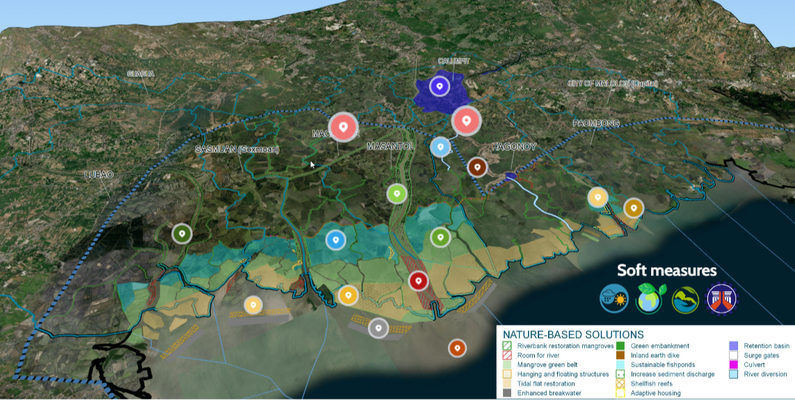B.M.L.de Vries1
1Royal HaskoningDHV, The Netherlands
Corresponding author: bente.de.vries@haskoningdhv.com
Introduction
Over the next 40 years, the urban area in the catchment of Manila Bay is expected to have roughly doubled, with a population increase from 33 million people in 2015 to about 51 million people by 2050. This requires the greatest attention of the Government of the Philippines to adequately regulate the spatial and master plans.
One of the priority measures of the Manila Bay Sustainable Development Masterplan is to drastically reduce the exposure of people, properties, and livelihood to flooding, especially informal settler families in hazard-prone areas. This is achieved by establishing a Coastal Line of Defence (CLD), relocating residents in extreme-subsiding barangays (i.e., seaward of the CLD) and implementing nature-based coastal protection programmes.
Royal HaskoningDHV was contracted to identify sustainable, nature-based flood protection measures as part of a Flood Protection Strategy for the north of Manila Bay, which ties in with the Sustainable Development Master Plan (MBSDMP). The project was initiated and funded by the government of the Netherlands, through its Partners for Water program.
Objective and Methods
The goal of the North Manila Bay Flood Protection Strategy is: "To develop a Flood Protection Strategy which identifies sustainable, nature-based flood protection measures for the Northern Manila Bay coastal area, and to recommend pilot locations for implementation of these measures."
The foundation of the protection strategy is a root cause analysis of the flooding problems. In addition, a total of approximately 50 meetings/workshops were held to collect input and opinions from over 20 different stakeholders. This was done to involve them in the decision-making process and ensure sustainable outcomes. Priority areas were defined and assessed for exposure to various flood related criteria. A longlist of Nature-based Solutions (NBS) was created, which were scored on effect on coastal and river flooding, storm surges wave attack, property and livelihood damage, environmental impact, institutional complexity, and social impact. The above input along with inspiration from EcoShape/Wetlands International’s earlier work, was combined to develop NBS overview maps. These maps show what the full implementation of the strategy would look like. Finally, pilot locations were identified to serve as a catalyst for implementing the strategy and Nature-based Solutions in the Philippines as a whole.
Results
The main result is a flood protection strategy for Manila Bay that can be used by the various stakeholders in the area. It focuses on a practical institutional setup and small-scale projects to initiate the strategy.
Important root causes for the flooding problems included the decline of natural habitat, climate change-induced sea-level rise and land subsidence. Stakeholder input confirmed these causes and applicable Nature-based Solutions have been shaped accordingly. This resulted in twenty possible Nature-based Solutions and “soft-measures” that will positively impact the flood susceptibility of the region if implemented. The strategy acknowledges that there are many parallel and interfacing developments in the area. Coordination and alignment between these developments are fundamental for their individual success. The institutional setup considers a long-term scenario focused on the wider strategy implementation and a short-term scenario for pilot implementation.
The strategy shows that Nature-based Solutions are vital in providing protection from climate change impacts and other flood-related hazards. Simultaneously, they can facilitate a transition towards alternate/adaptable livelihoods and habitat restoration. In this way, the North Manila Bay Flood Protection Strategy contributes to increasing and restoring the biodiversity in the North Manila Bay area.

Map with Nature-based Solutions for North Manila Bay.
References
Nell, J. (2022). North Manila Bay Flood Protection Strategy. Royal HaskoningDHV, Netherlands Enterprise Agency.










